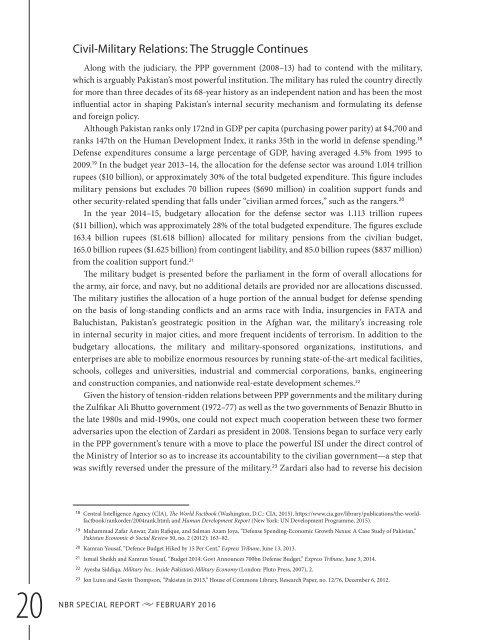pakistan’s
SR55_Mapping_Pakistan_February2016
SR55_Mapping_Pakistan_February2016
Create successful ePaper yourself
Turn your PDF publications into a flip-book with our unique Google optimized e-Paper software.
Civil-Military Relations: The Struggle Continues<br />
Along with the judiciary, the PPP government (2008–13) had to contend with the military,<br />
which is arguably Pakistan’s most powerful institution. The military has ruled the country directly<br />
for more than three decades of its 68-year history as an independent nation and has been the most<br />
influential actor in shaping Pakistan’s internal security mechanism and formulating its defense<br />
and foreign policy.<br />
Although Pakistan ranks only 172nd in GDP per capita (purchasing power parity) at $4,700 and<br />
ranks 147th on the Human Development Index, it ranks 35th in the world in defense spending. 18<br />
Defense expenditures consume a large percentage of GDP, having averaged 4.5% from 1995 to<br />
2009. 19 In the budget year 2013–14, the allocation for the defense sector was around 1.014 trillion<br />
rupees ($10 billion), or approximately 30% of the total budgeted expenditure. This figure includes<br />
military pensions but excludes 70 billion rupees ($690 million) in coalition support funds and<br />
other security-related spending that falls under “civilian armed forces,” such as the rangers. 20<br />
In the year 2014–15, budgetary allocation for the defense sector was 1.113 trillion rupees<br />
($11 billion), which was approximately 28% of the total budgeted expenditure. The figures exclude<br />
163.4 billion rupees ($1.618 billion) allocated for military pensions from the civilian budget,<br />
165.0 billion rupees ($1.625 billion) from contingent liability, and 85.0 billion rupees ($837 million)<br />
from the coalition support fund. 21<br />
The military budget is presented before the parliament in the form of overall allocations for<br />
the army, air force, and navy, but no additional details are provided nor are allocations discussed.<br />
The military justifies the allocation of a huge portion of the annual budget for defense spending<br />
on the basis of long-standing conflicts and an arms race with India, insurgencies in FATA and<br />
Baluchistan, Pakistan’s geostrategic position in the Afghan war, the military’s increasing role<br />
in internal security in major cities, and more frequent incidents of terrorism. In addition to the<br />
budgetary allocations, the military and military-sponsored organizations, institutions, and<br />
enterprises are able to mobilize enormous resources by running state-of-the-art medical facilities,<br />
schools, colleges and universities, industrial and commercial corporations, banks, engineering<br />
and construction companies, and nationwide real-estate development schemes. 22<br />
Given the history of tension-ridden relations between PPP governments and the military during<br />
the Zulfikar Ali Bhutto government (1972–77) as well as the two governments of Benazir Bhutto in<br />
the late 1980s and mid-1990s, one could not expect much cooperation between these two former<br />
adversaries upon the election of Zardari as president in 2008. Tensions began to surface very early<br />
in the PPP government’s tenure with a move to place the powerful ISI under the direct control of<br />
the Ministry of Interior so as to increase its accountability to the civilian government—a step that<br />
was switly reversed under the pressure of the military. 23 Zardari also had to reverse his decision<br />
18 Central Intelligence Agency (CIA), The World Factbook (Washington, D.C.: CIA, 2015), https://www.cia.gov/library/publications/the-worldfactbook/rankorder/2004rank.html;<br />
and Human Development Report (New York: UN Development Programme, 2015).<br />
19 Muhammad Zafar Anwar, Zain Rafique, and Salman Azam Joya, “Defense Spending-Economic Growth Nexus: A Case Study of Pakistan,”<br />
Pakistan Economic & Social Review 50, no. 2 (2012): 163–82.<br />
20 Kamran Yousaf, “Defence Budget Hiked by 15 Per Cent,” Express Tribune, June 13, 2013.<br />
21 Ismail Sheikh and Kamran Yousaf, “Budget 2014: Govt Announces 700bn Defense Budget,” Express Tribune, June 3, 2014.<br />
22 Ayesha Siddiqa, Military Inc.: Inside Pakistan’s Military Economy (London: Pluto Press, 2007), 2.<br />
20<br />
NBR<br />
23 Jon Lunn and Gavin Thompson, “Pakistan in 2013,” House of Commons Library, Research Paper, no. 12/76, December 6, 2012.<br />
SPECIAL REPORT u FEBRUARY 2016



